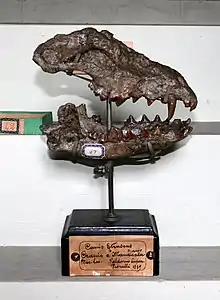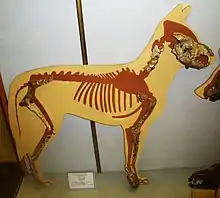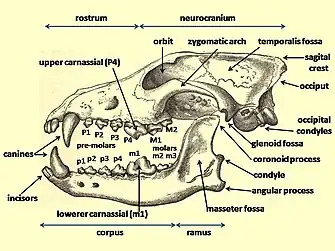| Canis etruscus Temporal range: Early Pleistocene 1.9-1.6 Ma | |
|---|---|
 | |
| Skull in the Montevarchi Paleontological Museum | |
| Scientific classification | |
| Domain: | Eukaryota |
| Kingdom: | Animalia |
| Phylum: | Chordata |
| Class: | Mammalia |
| Order: | Carnivora |
| Family: | Canidae |
| Genus: | Canis |
| Species: | †C. etruscus |
| Binomial name | |
| †Canis etruscus Forsyth Major, 1877[1] | |
Canis etruscus, the Etruscan wolf, is an extinct species of canine that was endemic to Mediterranean Europe during the Early Pleistocene. The Etruscan wolf has been described as a small wolf-like dog. The Etruscan wolf has been accepted as the ancestor of C. mosbachensis, that is the ancestor of the grey wolf (C. lupus), for a long time.[2] Recent research has suggested that C. borjgali from Dmanisi has to be considered the ancestor of C. mosbachensis.[3][4]
Taxonomy

The fossil record for ancient vertebrates is composed of rarely occurring fragments, from which it is often impossible to obtain genetic material. Researchers are limited to morphologic analysis but it is difficult to estimate the intra-species and inter-species variations and relationships that existed between specimens across time and place. Some observations are debated by researchers who do not always agree, and hypotheses that are supported by some authors are challenged by others.[2] Several species of Caninae from the Pleistocene of Europe have been described. Most of their systematic and phylogenetic relationships have not been resolved because of their similar morphology.[5]
Upper Valdarno is the name given to that part of the Arno valley situated in the provinces of Florence and Arezzo, Italy. The region is bounded by the Pratomagno mountain range to the north and east and by the Chianti mountains to the south and west. The Upper Valdarno Basin has provided the remains of three fossil canid species dated to the Late Villafranchian era of Europe, 1.9–1.8 million years ago, that arrived with a faunal turnover around that time. The Swiss paleontologist Charles Immanuel Forsyth Major discovered two species in this region, these being the Falconer's wolf (Canis falconeri Forsyth Major 1877) that was later reclassified as Lycaon falconeri, and the smaller Etruscan wolf (C. etruscus Forsyth Major 1877).[6] Forsyth Major did not publish a complete description of the Etruscan wolf,[5] and later Domenico Del Campana worked on expanding Forsyth Major's descriptions when he recognized among the specimens a smaller, jackal-sized species.[5] This he named the Arno River dog[6] (C. arnensis Del Campana 1913) in honour of the nearby Arno river.[5]
Type Specimen
_-_C._etruscus.png.webp)
The lectotype is a cranium from an unrecorded locality of Upper Valdarno. It is housed in the Montevarchi Paleontological Museum. The specimen has been designed as lectotype by the Italian paleontologist Danilo Torre in 1967 from the sample described by Forsyth Major.[5]
Canis apolloniensis
One specimen of C. apolloniensis (Koufos and Kostopoulos, 1997[7]) was found in site of Apollonia-1 near the village of Nea Apollonia, Macedonia, in northern Greece.[7][8] The holotype consists of the rostral portion of a skull and a mandible. In 2011, a study compared all of the fifty-five Early Pleistocene wolf-like specimens found across Europe and suggested that their morphometric variation was no different to that of modern wolf populations, with their difference in size representing male and female specimens. However, the study proposed two lineages. One lineage is C. arnensis which includes C. accitanus and C. senezensis, and the other lineage being C. etruscus that includes C. apolloniensis.[9] Other studies[10][11][8] contrast with this biometric interpretation. Considering morphological features retained by C. apolloniensis, this species should be considered as a synonym of C. mosbachensis or a very affine taxon.
Lineage
The large wolf-sized Canis first appeared in the Middle Pliocene about 3 million years ago in the Yushe Basin, Shanxi Province, China. 2.5 million years ago its range included the Nihewan Basin in Yangyuan County, Hebei, China, and Kuruksay, Tajikistan.[12] In Europe, C. etruscus first appeared 1.9-1.8 million years ago.[6] The lineage from C. etruscus to the Mosbach wolf (C. mosbachensis Soergel, 1925) to the grey wolf (C. lupus) is widely accepted in the European scientific literature.[13][4][14][15][16][17][18][19][20] Nevertheless, a recent publication[3] has challenged this well-established hypothesis showing that the peculiarity of the C. etruscus (as shown by Cherin et al., 2014[5]) do not fit with those of more modern Early Pleistocene canids like C. borjgali from Dmanisi, probably the ancestor wolf-like crown-clade species (C. lupus, C. latrans, C. lupaster). The French archaeologist Jean-Philip Brugal proposes C. mosbachensis as a subspecies of C. etruscus,[9] and another French archaeologist, Henry de Lumley, considers C. mosbachensis to be a subspecies of the grey wolf and proposes a classification of C. lupus mosbachensis.[21]
Paleoecology
The dispersal of carnivoran species occurred approximately 1.8 million years ago and this coincided with a decrease in precipitation and an increase in annual seasonality which followed the 41,000-year amplitude shift of Milankovitch cycles. First to arrive was C. etruscus, which was immediately followed by C. arnensis and Lycaon falconeri, and then the giant hyena Pachycrocuta brevirostris. These were all better adapted to open, dry landscapes[5][6] than the two more primitive canini Eucyon and Nyctereutes that they replaced in Europe.[19]
Description

A description of the Etruscan wolf appears below:
Medium-sized dog (average size of a small C. lupus); elongated snout; marked constriction of the snout beyond the infraorbital foramina; elongated nasal bones extending beyond the maxillofrontal suture; well-developed sagittal and nuchal crests; laterally enlarged occipital region; P1-P2-P3 laterally compressed; P1 with lingual cingulum; P3 normally with both posterior and accessory cusp (=modified posterior cingulum); large relative length of the upper molar row (in comparison with C. arnensis); M1 with paracone more elevated than metacone; labial basin of M1 as deep as but larger than the lingual one; M1 and M2 with a continuous cingulum; reduced contact area between M1 and M2. Lower dentition characterized by larger dimensions in respect to C. arnensis and by a wolf-like M1/M2 ratio. The lower carnassial (M1) is distinguished by main trigonid cusps (protoconid and paraconid) relatively small (in comparison with C. lupus) and by talonid cusps (hypoconid and entoconid) linked by a sinuous cristid.[5]
Describing C. etruscus as wolf-like and C. arnensis as jackal-like is therefore an over-simplification, because C. arnensis is more similar to C. lupus than is C. etruscus in some cranial characters. C. etruscus shows a set of peculiar features.[5]
Range
In the Early Pleistocene, from Spain to China.[5]
Extinction
The Etruscan wolf and the Arno River dog both disappeared from the fossil record in Italy after the end of the Tasso Faunal Unit and were replaced by the mid-Pleistocene era Mosbach wolf (C. mosbachensis Soergel, 1925) by 1.5 million years ago.[6]
References
- ↑ Forsyth Major CI (1877) Considerazioni sulla fauna dei Mammiferi pliocenici e postpliocenici della Toscana. III. Cani fossili del Val d’Arno superiore e della Valle dell’Era. Mem Soc Tosc Sci Nat 3:207–227
- 1 2 Sardella, Raffaele; Bertè, Davide; Iurino, Dawid Adam; Cherin, Marco; Tagliacozzo, Antonio (2014). "The wolf from Grotta Romanelli (Apulia, Italy) and its implications in the evolutionary history of Canis lupus in the Late Pleistocene of Southern Italy". Quaternary International. 328–329: 179–195. Bibcode:2014QuInt.328..179S. doi:10.1016/j.quaint.2013.11.016.
- 1 2 Bartolini Lucenti, Saverio; Bukhsianidze, Maia; Martínez-Navarro, Bienvenido; Lordkipanidze, David (2020). "The wolf from Dmanisi and Augmented Reality: review, implications and opportunities". Frontiers in Earth Science. 8: 131. Bibcode:2020FrEaS...8..131B. doi:10.3389/feart.2020.00131. hdl:2158/1205943. ISSN 2296-6463.
- 1 2 Sotnikova, M (2010). "Dispersal of the Canini (Mammalia, Canidae: Caninae) across Eurasia during the Late Miocene to Early Pleistocene". Quaternary International. 212 (2): 86–97. Bibcode:2010QuInt.212...86S. doi:10.1016/j.quaint.2009.06.008.
- 1 2 3 4 5 6 7 8 9 10 Cherin, Marco; Bertè, Davide F.; Rook, Lorenzo; Sardella, Raffaele (2013). "Re-Defining Canis etruscus (Canidae, Mammalia): A New Look into the Evolutionary History of Early Pleistocene Dogs Resulting from the Outstanding Fossil Record from Pantalla (Italy)". Journal of Mammalian Evolution. 21: 95–110. doi:10.1007/s10914-013-9227-4. S2CID 17083040.
- 1 2 3 4 5 Bartolini Lucenti, Saverio; Rook, Lorenzo (2016). "A review on the Late Villafranchian medium-sized canid Canis arnensis based on the evidence from Poggio Rosso (Tuscany, Italy)". Quaternary Science Reviews. 151: 58–71. Bibcode:2016QSRv..151...58B. doi:10.1016/j.quascirev.2016.09.005.
- 1 2 Koufos, G. D.; Kostopoulos, D. (1997). "New carnivore material from the Plio-Pleistocene of Macedonia (Greece) with the description of a new canid". Münchner Geowissenschaften Abhlungen. 34: 33–63.
- 1 2 Koufos, G. (2018). "New Material and Revision of the Carnivora, Mammalia from the Lower Pleistocene Locality Apollonia 1, Greece". Quaternary. 1: 6. doi:10.3390/quat1010006.
- 1 2 Brugal, Jean-Philip; Boudadi-Maligne, Myriam (2011). "Quaternary small to large canids in Europe: Taxonomic status and biochronological contribution". Quaternary International. 243 (1): 171–182. Bibcode:2011QuInt.243..171B. doi:10.1016/j.quaint.2011.01.046.
- ↑ Martínez-Navarro, B.; Belmaker, M.; Bar-Yosef, O. (2009). "The large carnivores from 'Ubeidiya (early Pleistocene, Israel): biochronological and biogeographical implications". Journal of Human Evolution. 56 (5): 514–524. doi:10.1016/j.jhevol.2009.02.004. PMID 19427671.
- ↑ Bartolini Lucenti, S.; Alba, D. M.; Rook, L.; Moyà-Solà, S.; Madurell-Malapeira, J. (2017). "Latest Early Pleistocene wolf-like canids from the Iberian Peninsula". Quaternary Science Reviews. 162: 12–25. Bibcode:2017QSRv..162...12B. doi:10.1016/j.quascirev.2017.02.023 – via Elsevier Science Direct.
- ↑ Vislobokova, I., Sotnikova, M. & Dodonov, A., 2003 - Bio-events and diversity of the Late Miocene-Pliocene mammal faunas of Russia and adjacent areas - in: Reumer, J.W.F. & Wessels, W. (eds.) - DISTRIBUTION AND MIGRATION OF TERTIARY MAMMALS IN EURASIA. A VOLUME IN HONOUR OF HANS DE BRUIJN - DEINSEA 10: 563-574 [ISSN 0923-9308] Published 1 December 2003
- ↑ Kurtén, B. (1968). Pleistocene mammals of Europe. London: Weidenfeld and Nicolson. p. 317. ISBN 978-0-202-30953-8.
- ↑ Torre, D. (1967). "I cani Villafranchiani della Toscana". Palaeontographia Italica (in Italian). 63: 113–136.
- ↑ Torre, D. (1974). "Affinità dentali del cane della grotta di l'Escale". Rivista Italiana di Paleontologia e Stratigrafia (in Italian). 80: 147–156.
- ↑ Torre, D. (1979). "The Ruscinian and Villafranchian dogs of Europe". Bollettino della Società Paleontologica Italiana (in Italian). 18: 162–165.
- ↑ Martin, R. (1973). "Trois nouvelles espèces de Caninae (Canidae, Carnivora) des gisements Plio-Villafranchiens d'Europe. Documents des Laboratoires de Géologie de Lyon". Notes et Mémoires (in French). 57: 87–96.
- ↑ Sotnikova, M. (1989). "The carnivore mammals from the Pliocene to the early Pleistocene. Stratigraphic significance". Transactions of the Geological Institute of RAS. 440: 1–122.
- 1 2 Rook, L. (1993). I cani dell'Eurasia dal Miocene superiore al Pleistocene medio (Ph.D.). Universities of Modena, Bologna, Firenze, Roma "La Sapienza", Italy.
- ↑ Sotnikova, M. (2001). "Remains of Canidae from the Lower Pleistocene site of Untermassfeld". In Kahlke, R. D. (ed.). Das Plestozan von Untermassfled bei Meiningen (Thuringen), part 2. Vol. 40. Romisch-Germanisches Zentralmuseum. pp. 607–632. ISBN 978-3-7749-3080-3.
- ↑ Lumley, H. de, Kahlke, H.D., Moigne, A.M., Moulle, P.E., 1988. Les faunes de grands mammifères de la grotte du Vallonnet Roquebrune-Cap-Martin, Alpes-Maritimes. L’Anthropologie 92, 465–496.